Biology Specimen Paper 2024 Sec-B Solved for ICSE Class-10. Step by step solutions as council prescribe guideline of model sample question paper. During solutions of Biology specimen paper we explain with figure, graph, table whenever necessary so that student can achieve their goal in next upcoming exam of council. Visit official website CISCE for detail information about ICSE Board Class-10.
ICSE Class-10 Biology Specimen Paper 2024 Sec-B Solved
| Board | ICSE |
| Class | 10th (x) |
| Subject | Biology |
| Topic | Specimen Paper Solved |
| Syllabus | Revised Syllabus |
| Session | 2023-24 |
| Question Type | Sec-B (Descriptive) |
| Total question | 6 with Part |
| Max mark | 40 |
ICSE Biology Specimen Paper 2024 Solved Class-10
According to latest circular of CISCE 2024 board exam of ICSE will be on the base of analytical thinking and logical types questions. The council also added assertion and reason type questions to develop the skill and confidence among ICSE Students. So this year require more particle with concept base learning.
Warning :- before viewing solution view Question Paper
ICSE SPECIMEN QUESTION PAPER 2024
BIOLOGY
Maximum Marks: 80
- Time allowed: Two and half hours Answers to this Paper must be written on the paper provided separately.
- You will not be allowed to write during first 15 minutes.
- This time is to be spent in reading the question paper.
- The time given at the head of this Paper is the time allowed for writing the answers.
Section A is compulsory. Attempt any four questions from Section B.
The intended marks for questions or parts of questions are given in brackets [ ]
SECTION B Biology ICSE Specimen Paper Solved 2024 Class-10
(Attempt any four questions from this Section.)
Question 3:
(i) The gene of red hair is recessive to the gene for black hair. What will be the hair colour of a person if he inherits a gene for red hair from his mother and a gene for black hair from his father?
(ii) State Mendel’s Law of Dominance.
(iii) What are Homologous chromosomes?
(iv) Differentiate between Phenotype and Genotype.
(v) Draw a neat, labelled diagram of a duplicated chromosome.
Answer:
(i) Let the genotype of black hair be BB.
Let the genotype of red hair be bb (recessive gene given).
Therefore the genotype of the mother’s hair is bb while the father’s hair is BB.
Therefore the child will have black hair since it is dominant but will also contain the recessive red hair trait but will not be expressed i.e. Bb.
(ii) Mendel’s law of dominance states that in a heterozygote, one trait will conceal the presence of another trait for the same characteristic. Rather than both alleles contributing to a phenotype, the dominant allele will be expressed exclusively.
(iii) Homologous chromosomes are defined as two pieces of DNA within an organism who is a diploid (2n) which carry the same genes one from each parent i.e. one from a father and one from the mother.
(iv)
| Genotype | Phenotype |
| The hereditary information of the organism is in the form of genes in the DNA and remains the same throughout the life. | The characteristics of an organism which are visible are known as phenotypes. |
| The same genotype produces the same phenotype. | The same phenotype may or may not belong to the same genotype. |
| Present inside the body as genetic material. | Expression of genes as the external appearance. |
| The genotype is inherited from the parent to the offspring. | The phenotype is not inherited from the parent. |
(v)
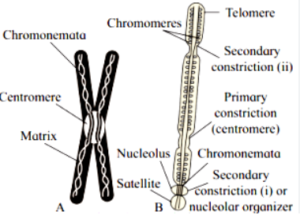
Question 4:
(i) Mention the exact location of Corpus callosum.
(ii) What are the two hormones secreted by Corpus luteum?
(iii) Differentiate between Menarche and Menopause.
(iv) What is the significance of placenta in the growth of foetus?
(v) Draw a neat, labelled diagram of a human gamete that has the sex chromosome.Y
Answer:
(i) Corpus callosum is a thick sheet of nerve fibers that is found between the two lobes of the cerebrum called cerebral hemispheres.
(ii) The primary hormone produced by the corpus luteum is progesterone, but it also produces inhibin A and estradiol. In the absence of fertilization, the corpus luteum will regress over time.
(iii) Menarche is the beginning of the menstrual cycle in females. Menopause is the ending phase of the menstrual cycle in females. Beginning of menarche is approximately between the age group of 11-16 years. Generally, menopause may occur between the age group of 45 – 50 years.
(iv) The placenta is an organ that develops in the uterus during pregnancy. This structure provides oxygen and nutrients to a growing baby. It also removes waste products from the baby’s blood.
(v) 
Question 5:
(i) Explain the term – Photsynthesis.
(ii) Write the overall chemical equation of Photosynthesis.
(iii) A potted plant having variegated leaves was exposed to sunlight for 3 hours. One ofthe leaves was plucked and tested for starch. What will be your observation after the starch test?
(iv) The initial food prepared by a green plant is A, which is later converted to food B by polymerization. Name food A and food B.
(v) Study the diagram given below and answer the questions that follow:
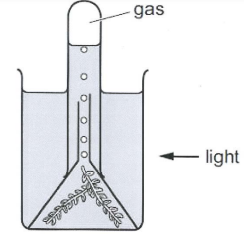
(a) Name the gas released when the setup was placed in sunlight.
(b) Give an example of an aquatic plant that can be used in the above experiment.
(c) What will happen if a pinch of Sodium bicarbonate is added to the water?
Answer:
(i) Photosynthesis is the process by which plants use sunlight, water, and carbon dioxide to create oxygen and energy in the form of sugar.
(ii) The process of photosynthesis is commonly written as: 6CO2 + 6H2O → C6H12O6 + 6O2. This means that the reactants, six carbon dioxide molecules and six water molecules, are converted by light energy captured by chlorophyll (implied by the arrow) into a sugar molecule and six oxygen molecules, the products.
(iii) Become Blue when Iodine drop on this leaves.
(iv) The leaves of the plant first prepare Glucose by photosynthesis, then glucose is converted to starch. Hence food A is Glucose and food B is starch. This is because starch is more stable than glucose especially in the presence of water.
(v)
(a) Oxygen
(b) Hydrilla
(c ) When baking soda or sodium Bicarbonate (NaHCo3) reacts with water carbonic acid is formed .The reaction is exothermic that is heat and Carbonic acid are produced. Carbonic acid is unstable so breaks up into carbon dioxide (fizzy or effervescence) and water.
So water will get hot plant will die soon.
Question 6:
(i) Give the exact location of genes.
(ii) Differentiate between Karyokinesis and Cytokinesis.
(iii) Mention two significant features of the stage Anaphase during Mitosis.
(iv) How many daughter cells are formed at the end of Mitosis and Meiosis?
(v) Study the diagram given below and answer the questions that follow:
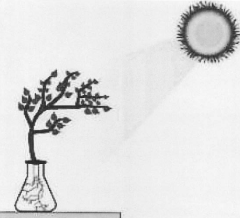
(a) Name the phenomenon depicted by the shoot in the above diagram.
(b) Which plant hormone plays an important role in the above movement?
(c) Name one stimulus which gives a positive response for the roots but negative response for the shoot.
Answer:
(i) Genes are contained in chromosomes, which are in the cell nucleus. A chromosome contains hundreds to thousands of genes.
(ii) Karyokinesis means the process of division of the nucleus. Cytokinesis means the process of division of cytoplasm. The nucleus gets divided into two daughter nuclei. The cytoplasm, cell organelles and the nuclei divide and are passed on to daughter cells equally.
(iii) The main characteristic of the anaphase of mitosis is the separation of two sister chromatids and their migration to the poles of the cell. During the process, the centromeres readily divide to give birth to two chromosomes.
(iv) Mitosis creates two identical daughter cells that each contain the same number of chromosomes as their parent cell. In contrast, meiosis gives rise to four unique daughter cells, each of which has half the number of chromosomes as the parent cell.
(v)
(a) Positive photo tropism
(b) Auxin
(c) water
(Biology Specimen Paper 2024 Sec-B Solved for ICSE Class-10)
Question 7:
(i) What is the scientific name for man?
(ii) What are vestigial organs? Give one example.
(iii) State two structural differences between an artery and vein.
(iv) Mention any two features of the Cro-Magnon man.
(v) Study the picture given below and answer the questions that follow:
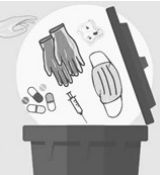
(a) Name the category of waste that is being disposed.
(b) Give an example of such a waste.
(c) Are they hazardous to humans and animals? Give a suitable reason to justify your answer.
Answer:
(i) The scientific name of human beings is Homo sapiens and it was coined by Carl Linnaeus in the year 1758.
(ii) In humans, the appendix is a good example of a vestigial organ. This non-functioning organ eventually degenerates, shrinking in size and disappearing ultimately. Examining vestigiality should be governed by drawing similarities with their counterparts with respect to their homologous features.
(iii) Structural difference between veins and arteries is Veins have thin walls whereas arteries have thicker walls. Veins haves valves arteries do not have valves.
(iv) Main characteristics of Cro-Magnon man:
- They were cave-dwelling and more advanced than Neanderthal man.
- Their cranial capacity was about 1660cc, much more than modern humans.
(v)
(a) Non- biodegradable
(b) Gloves use in hospital
(c) Yes, these waste release harmful gases on burning.
Question 8:
(i) Define – Osmosis.
(ii) Name the two sensory cells in retina meant for light adaptation.
(iii) Mention one function each for – Cerebrum and Cerebellum.
(iv) State any two objectives of Swachh Bharat Abhiyan.
(v) Given below is the diagram of human blood smear. Answer the questions that follow:
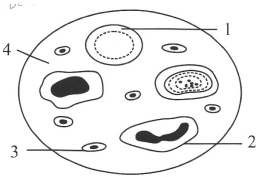
(a) Mention one structural difference between 1 and 2.
(b) What is the function of part 3?
(c) Name the part labelled 4.
Answer:
(i) Osmosis is the movement of water molecules from a solution with a high concentration of water molecules to a solution with a lower concentration of water molecules, through a cell’s partially permeable membrane.
(ii) The primary light-sensing cells in the retina are the photoreceptor cells, which are of two types: rods and cones. Rods function mainly in dim light and provide monochromatic vision.
(iii) Your cerebrum sends the signals to the muscles in your arms, and your cerebellum helps calculate and control your movements, so your hand goes right to the pencil without missing.
(iv) Encourage cost effective and appropriate technologies for ecologically safe and sustainable sanitation. Develop community managed environmental sanitation systems focusing on solid & liquid waste management for overall cleanliness in the rural areas.
(v)
(a)
| RBC | Neutrophil |
| Biconcave, disc-shaped | Amoeboid |
| Do not have nucleus | Have 3-5 lobbed nucleus |
(b) Blood clotting
(c) Blood Plasma
–: Visit also :–
Return to : ICSE Specimen Paper 2024 Solved
Thanks



I want whole paper solution but there is not whole paper solution and also not correct answer